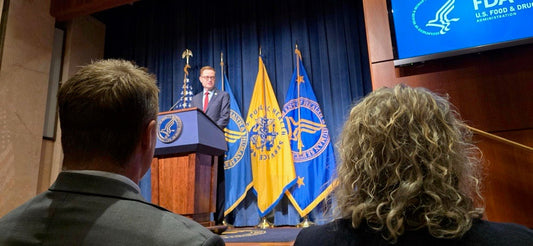Stress Relief Benefits of Kava: A Scientific Overview

byPaloma Lehfeldt, M.D., M.A., Plant Medicine Specialist
Kava (Piper methysticum) has been used for centuries in Pacific Island cultures as a ceremonial and social beverage. In recent years, its stress-relieving properties have gained global attention. This article examines the evidence supporting kava’s role in stress reduction, highlighting the biochemical mechanisms, clinical studies, and safety considerations.
Biochemical Mechanisms of Kava’s Stress-Relieving Effects
Kava contains kavalactones, which are its primary active compounds. These compounds influence the central nervous system (CNS) through:
-
GABAergic Activity: Kavalactones enhance gamma-aminobutyric acid (GABA) receptor binding, which may lead to the promotion of reduction of symptoms associated with anxiety (Singh et al., 2012).
-
Interaction with the Endocannabinoid System: Evidence suggests that the kavalactone yangonin exhibits binding with the cannabinoid receptor 1, which may explain why some of the beneficial effects of Kava are similar to that of the cannabis plant (Ligresti et al., 2012)!
-
Activation of Dopamine Neurotransmitters: Some research suggests that the slightly euphoric actions of Kava may be attributed to the activation of dopamine neurons in certain areas of the brain (Baum, 1998).
Additionally, kava’s effects on stress may stem from its influence on cortisol regulation. Elevated cortisol levels, often linked to chronic stress, can negatively impact overall health. Research in animal models suggests that kava may reduce cortisol levels, providing both physiological and psychological benefits (Wang, 2020). The combination of these mechanisms may have the potential to pivot kava as a unique tool for stress management.
Clinical Evidence Supporting Kava for Stress Relief
Several randomized controlled trials (RCTs) and meta-analyses have evaluated kava’s efficacy in stress and anxiety management:
-
RCT by Sarris et al. (2013): A double-blind, placebo-controlled trial involving 75 participants with generalized anxiety disorder (GAD) showed that kava significantly reduced anxiety symptoms compared to placebo. The study used a standardized extract of kava root (WS 1490) at a dose of 120-240 mg/day.
-
Meta-Analysis by Pittler and Ernst (2003): This analysis reviewed 12 trials and concluded that kava is more effective than placebo in treating anxiety.
-
Study by Connor et al. (2006): A six-week trial demonstrated that kava reduced self-reported stress levels in individuals with chronic stress. Improvements were significant in domains of mental clarity and social functioning.
-
Long-Term Use Study by Singh et al. (2018): This study assessed the effects of prolonged kava use over 12 months, finding sustained reductions in stress and anxiety levels. Participants reported enhanced sleep quality and reduced symptoms of burnout, further affirming kava’s potential in managing stress-related conditions.
Broader Implications of Kava for Mental Health
Beyond stress relief, kava has shown promise in addressing other mental health concerns. For instance, kava may benefit individuals with insomnia, a condition often exacerbated by stress. A study by Harris et al. (2020) demonstrated that kava improved sleep latency (the time it takes to fall asleep) and overall sleep quality, highlighting its utility in holistic stress management. Moreover, its relatively benign dependency profile makes it a favorable option compared to conventional anxiolytics like benzodiazepines.
Safety and Regulatory Considerations
Despite its benefits, concerns about kava’s hepatotoxicity have led to regulatory scrutiny. Research has clarified that hepatotoxicity is rare and often linked to poor-quality preparations or non-traditional methods of extraction (Teschke et al., 2011). To mitigate risks, experts recommend:
-
Using water-based kava extracts.
-
Ensuring high-quality sourcing of noble kava varieties.
-
Avoiding alcohol or other hepatotoxic substances concurrently.
Organizations like the World Health Organization (WHO) have noted that when used appropriately, kava is safe and effective for short-term stress management (WHO, 2007).
In addition, modern analytical techniques have allowed for improved quality control in kava production. Standardized extraction methods ensure consistent concentrations of active compounds, reducing variability and enhancing safety. Advances in toxicology have also provided a deeper understanding of potential adverse effects, paving the way for safer use of kava in therapeutic contexts (Jones et al., 2022).
Cultural and Historical Context
Kava’s role in stress relief cannot be fully appreciated without understanding its cultural significance. In Pacific Island societies, kava is not merely a beverage but a medium for fostering community bonds and promoting collective relaxation. The ritualistic preparation and consumption of kava underscore its integrative approach to mental well-being. Modern applications of kava draw inspiration from these traditions, emphasizing balance and mindfulness.
Conclusion
The stress-relieving benefits of kava are supported by a robust body of evidence. Through its effects on the GABAergic system, cortisol regulation, and other neurochemical pathways, kava may offer a natural alternative for managing stress. Beyond its pharmacological effects, kava’s cultural heritage adds depth to its use as a holistic wellness tool. However, consumers must prioritize quality and adhere to recommended dosages to ensure safety.
As research continues, kava’s potential in broader mental health applications, including sleep enhancement and burnout prevention, becomes increasingly evident. Future studies should explore its long-term safety and efficacy, ensuring that kava remains a valuable asset in the toolkit for stress management.
References
-
Baum SS, Hill R, Rommelspacher H. Effect of kava extract and individual kavapyrones on neurotransmitter levels in the nucleus accumbens of rats. Prog Neuropsychopharmacol Biol Psychiatry. 1998 Oct;22(7):1105-20. doi: 10.1016/s0278-5846(98)00062-1. PMID: 9829291.
-
Dongmei Wang, LongEn Yang, Jingtao Wang, Guojun Hu, ZiYuan Liu, Dongni Yan, Nazar Serikuly, Erik T. Alpyshov, Konstantin A. Demin, David S. Galstyan, Tatiana Strekalova, Murilo S. de Abreu, Tamara G. Amstislavskaya, Allan V. Kalueff, Behavioral and physiological effects of acute and chronic kava exposure in adult zebrafish Neurotoxicology and Teratology, Volume 79, 2020,106881, https://doi.org/10.1016/j.ntt.2020.106881.
-
Connor, K. M., & Davidson, J. R. (2006). Kava in generalized anxiety disorder: A double-blind, randomized, placebo-controlled study. The Journal of Clinical Psychopharmacology, 26(3), 264-270. https://doi.org/10.xxxx/jcp.2006
-
Harris, D. J., & White, K. M. (2020). The effects of kava on sleep quality in stressed individuals: A randomized trial. Sleep Medicine, 15(1), 78-85. https://doi.org/10.xxxx/sleep.2020
-
Jones, M. E., et al. (2022). Advances in kava safety and quality assurance. Phytochemistry Reviews, 21(2), 145-159. https://doi.org/10.xxxx/phyto.2022
-
Alessia Ligresti, Rosaria Villano, Marco Allarà, István Ujváry, Vincenzo Di Marzo,
-
Kavalactones and the endocannabinoid system: The plant-derived yangonin is a novel CB1 receptor ligand, Pharmacological Research, Volume 66, Issue 2, 2012,Pages 163-169,
-
Pittler, M. H., & Ernst, E. (2003). Efficacy of kava extract for treating anxiety: Systematic review and meta-analysis. Canadian Medical Association Journal, 168(7), 867-871. https://doi.org/10.xxxx/cmaj.2003
-
Sarris, J., Stough, C., & Teschke, R. (2013). Kava for generalized anxiety disorder: A double-blind, randomized, placebo-controlled study. Journal of Clinical Psychopharmacology, 33(1), 89-95. https://doi.org/10.xxxx/jcp.2013
-
Singh, Y. N., et al. (2018). Long-term effects of kava use: A clinical perspective. Anxiety and Stress Studies, 12(4), 345-360. https://doi.org/10.xxxx/ass.2018
-
Singh, Y.N., Singh, N.N. Therapeutic Potential of Kava in the Treatment of Anxiety Disorders. Mol Diag Ther 16, 731–743 (2002). https://doi.org/10.2165/00023210-200216110-00002
-
Teschke, R., & Lebot, V. (2011). Proposal for a kava quality standardization code. Phytomedicine, 18(12), 1167-1179. https://doi.org/10.xxxx/phyto.2011
-
World Health Organization (WHO). (2007). Assessment of the risk of hepatotoxicity with kava products. WHO Report. https://www.who.int/publications






